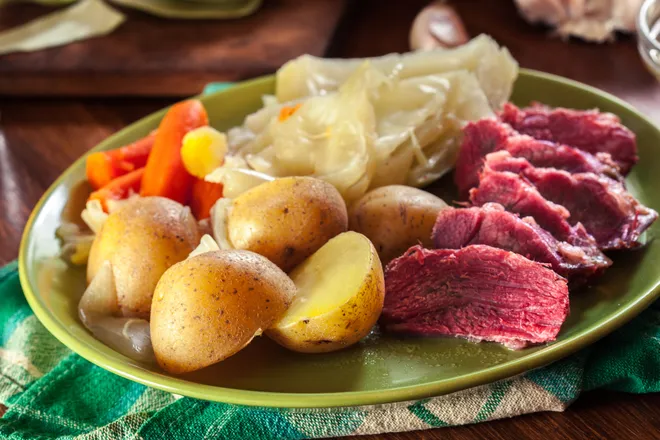How to cook corned beef: A recipe (plus a history lesson) this St. Patrick's Day
St. Patrick’s Day is approaching, meaning it’s almost time to don your best green suit, set a leprechaun trap and cook a festive Irish meal.
The holiday celebrates the patron saint of Ireland who, incidentally, wasn’t even Irish. Saint Patrick was born in Britain, taken prisoner by Irish raiders and held for six years before escaping. He eventually returned to Ireland as a missionary and became a symbol for a blend of traditional Irish culture and Christianity.
But what about the lore behind other St. Patrick’s Day symbols? Here’s a look at how corned beef became a purported Irish classic.

What is corned beef?
Corned beef is cured brisket, which means it’s been preserved in a salty brine. It’s similar to pastrami, which is also brined brisket, but corned beef is boiled while pastrami is smoked.
Corned beef gets its shining moment on St. Patrick’s Day as a “traditional” Irish food. Much like St. Patrick himself, however, corned beef is not technically Irish.
According to the History Channel, Irish immigrants in New York City learned about corned beef from their Jewish neighbors and adopted it instead of Irish bacon, a costly but traditional food. Cabbage got tacked onto the meal because it was abundant, cheap and bulked up the stew pot with other vegetables. The meal gained popularity in the New York bar scene because it was offered as a “free lunch” to Irish construction workers if they bought beers or shots of whiskey.
“I don’t know anybody who serves corned beef in Ireland on St. Patrick’s Day,” Myrtle Allen, the famed Irish chef often credited with “the revolution in Irish food,” told the Washington Post in 1996. Corned beef is “no more Irish than roast chicken,” she said.
The British Empire did extensively import corned beef from Ireland from the 17th to 19th centuries, when County Cork was known as the “capital of corned beef” according to The Irish Times.
However, a more typical Irish celebratory meal would be thick slabs of Irish bacon or another type of pork with mashed potatoes and vegetables served with a white sauce.
Why is it called corned beef?
The “corn” in corned beef has nothing to do with the yellow vegetable. It comes instead from the large salt crystals used to preserve the beef, which were sometimes called “kernels.”
How to cook corned beef and cabbage
Food Network recommends making the brine yourself with water, pickling spices (mustard seeds, peppercorns, cloves, allspice, juniper berries, bay leaves and red pepper flakes), sugar, kosher salt and pink curing salt. Pink curing salt is regular table salt with sodium nitrate and is used to preserve meats.
Bring the brine mixture to a boil and simmer until the sugar dissolves and let it cool. Pour the mixture into a bag with the brisket and seal it as tightly as possible. Leave it in the fridge for five to seven days, flipping it over every other day.
The meat can be cooked in a cast iron Dutch oven at a low temperature.
You can also save a few steps by making it in a pressure cooker. Buy a pre-seasoned beef brisket and rub it with brown sugar. Place it on a wire rack in your instant pot with garlic cloves and 1 ½ cans of beer and pressure cook it on high for 90 minutes.
When it’s done, add your veggies – carrots, cabbage, onions and potatoes – and the rest of the beer to the remaining liquid and pressure cook on high for 5 minutes.
When is St. Patrick's Day?When we celebrate in 2024 and why
Just Curious for more? We've got you covered.
USA TODAY is exploring the questions you and others ask every day. From "How do you play Euchre?" to "Who was Jack the Ripper?" to "How long does ground beef last in the fridge?" — we're striving to find answers to the most common questions you ask every day. Head to our Just Curious section to see what else we can answer for you.
Disclaimer: The copyright of this article belongs to the original author. Reposting this article is solely for the purpose of information dissemination and does not constitute any investment advice. If there is any infringement, please contact us immediately. We will make corrections or deletions as necessary. Thank you.







